Back to Home Page / Back to 'About Us' / Back to Anna's Page
Jadwiga
Most of my documentation and personal signatures show me as J Anna - this is not an affectation. The initial J stands for Jadwiga - a beautiful Polish name which points to my heritage. I was given the name by my parents in deference to one of Poland's most famous saints, Jadwiga, Królowa Polski (Queen of Poland). Not to be confused with another royal Jadwiga Śląska (Silesia). Their (patron) saints days are celebrated on either the 15th or 16th of October and confusion reigns constantly - I have always celebrated my patron saint's day on 15th October.
This does not explain why I do not use the name on an everyday basis. All members of our family have two 'first' names (previously known as 'Christian' names) and a name of choice received at confirmation - mine is Maria.
Unfortunately, computers do not allow for a second name to be used as a first name, so I am constantly, even after all this years, greatly upset by the mispronunciation of this beautiful name. The first syllable, 'Jad', is not pronounced with a hard 'j' as in 'jag(uar)' for instance, but as in 'Yad' (Vashem). The second syllable, 'wig' is not pronounced as the English word for hair piece, but with a 'v' sound transposing the 'w' with the same strength as the 'vid' in the word video. The final 'a' is short and sharp and not as in 'ay'. If you choose to look at the video of the Polish tennis player you will hear her pronounce the name correctly.
Variations of the name are 'Edwige' (in French and which pronunciation I do like) and 'Hedwig' from the German also used as a name for Harry Potter's owl.
I thought that it would be appropriate to devote a page to women bearing the name of Jadwiga in my personal section.
I will start with our great-aunt:
'Ciocia Jadzia' - Jadwiga Tintz :
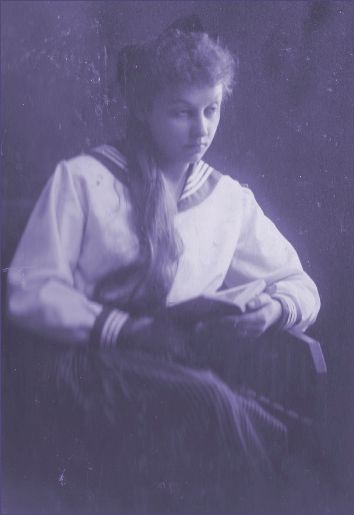
Our cousin Sister Jadwiga
A nun in the religious order of
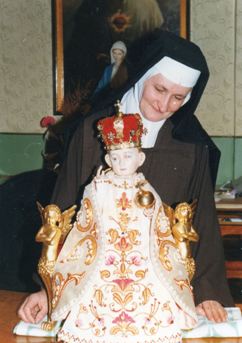
JEDRZEJOWSKA, JADWIGA (“JAJA” or “Jed”)
1930s Polish Tennis Star - Jadwiga Jędrzejowska
Fabulous Portrait of JJ in 1933
A rare still of JJ playing at Wimbledon where she reached the Final in 1937
Poland
Born 15 October 1912 in Kraków / Died 28 February 1980 in Katowice / Married Alfred Gallert, 1947
Played under maiden name after marriage. Unlucky never to have won a major title. Her forehand was the biggest of her era. She remains the greatest ever Polish player,make or female.
Jędrzejowska reached the singles final of a Grand Slam tournament on three occasions, still a record for Polish tennis.
Wimbledon (1937): lost to Dorothy Round 6–2, 2–6, 7–5.
US Championships (1937): lost to Anita Lizana 6–4, 6–2.
French Championships (1939): lost to Simone Mathieu 6–3, 8–6.
In women's doubles, Jędrzejowska won the 1939 French Championships with Mathieu, defeating Alice Florian and Hella Kovac in the final 7–5, 7–5. Jędrzejowska's record in other Grand Slam women's doubles finals was as follows:
French Championships (1936): Jędrzejowska and Susan Noel lost to Mathieu and Billie Yorke 2–6, 6–4, 6–4.
US Championships (1938): Jędrzejowska and Mathieu lost to Alice Marble and Sarah Palfrey Cooke 6–8, 6–4, 6–3.
In the mixed doubles final at the 1947 French Championships, Jędrzejowska and Christian Caralulis lost to Eric Sturgess and Sheila Summers 6–0, 6–0.
At the age of 44, Jędrzejowska reached the women's doubles quarterfinals of the 1957 French Championships with partner Pilar Barril.
According to Wallis Myers and John Olliff of The Daily Telegraph and The Daily Mail, Jędrzejowska was ranked in the world top ten from 1936 through 1939 (no rankings issued from 1940 through 1945), reaching a career high of World No. 3 in those rankings in 1937.
Played the French 9 times from 1931 to 1948, making SF in 1937 and RU in 1939.
Played Wimbledon 10 times from 1931 to 1947. QF 1935,38-39, SF 36, RU in 1937.
Played US in 1937 (RU) and 1938 (QF).
All 21 slams she made the QF 4 times, SF twice, and twice RU.
2019 - Tennis in Kraków Remembers
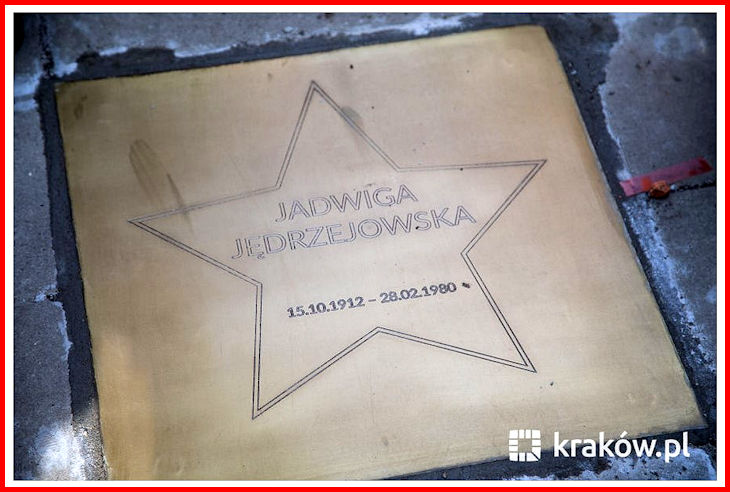
In 2019 Poland honoured its Tennis Athletes with a "Tennis Stars Alley" not unlike the "Walk of Fame" in Hollywood - past and present, living and dead were remembered and the most successful 1930s player was, I am delighted to say, amongst them! Jadwiga Jędrzejowska deserves her place amongst the best of them! Image sourced from the aptly named Magiczny Kraków (Magical Kraków) - for more about the honours and translations visit the post-tennis Aga page
Jadwiga, Królowa Polski (Queen of Poland)
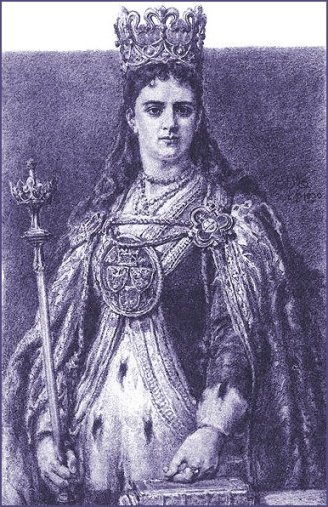
As illustrated by Jan Matejko the endearing image I was brought up with whilst learning the history of Poland
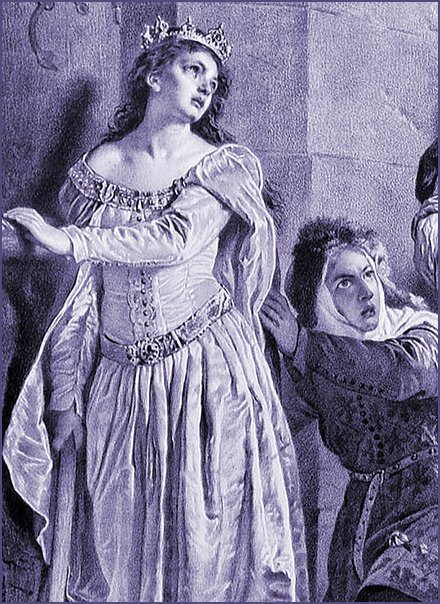
Lithographic pint made by W. Walkiewicz according to painting of Wojciech Gerson. Edited for Art Associations in Lviv (Lwów) in 1876
In 2020, thanks to our cousin in Poland who sends us magazines on a regular basis, my sister, Marysia, found an article about the young Jadwiga and her part in Polish history. Not a mind-blowing account by any means, but one that led us to an interesting adventure/quest/query - remember, we no longer have parents who are alive, so we seek information from different sources!
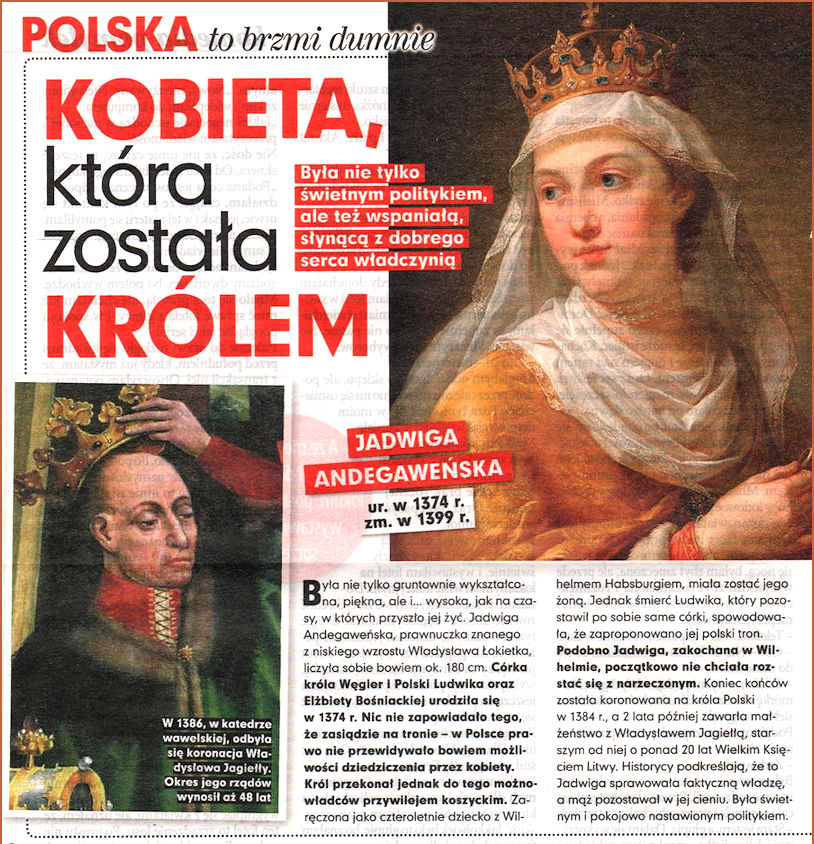
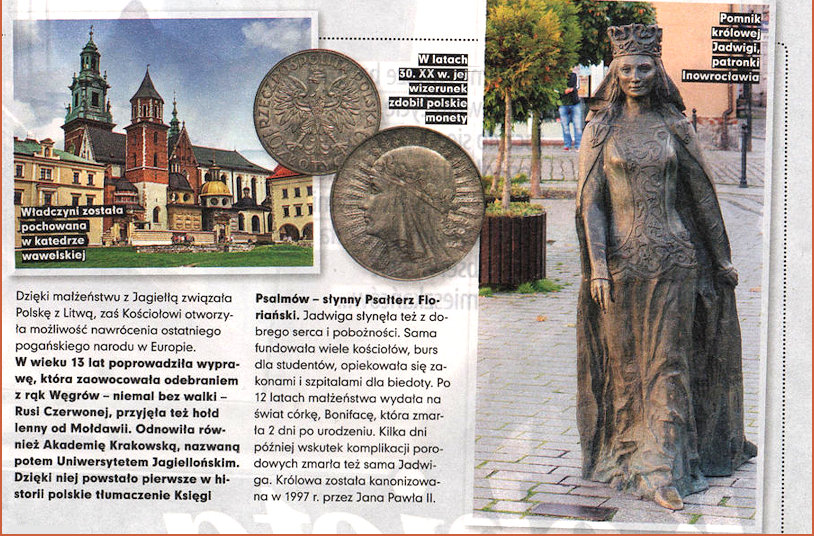
What astonished us was the sheer beauty of the image on the coin and the statue in Inowrocław - the coin in particular fascinated my sister so naturally I was determined to find out more about it and get hold of one if I possibly could! (Ebay is very good for that sort of thing!)
Historically the coins were only minted in 1932 and 1933 with a value of 5 or 10 złotys (100 grosz(es) made up 1 złoty - so the value of the larger coins will have been substantial at the time. Our mother would have been 14 in 1932 - would she have owned such a coin, even the lesser valued one at the time. We like to think she would!
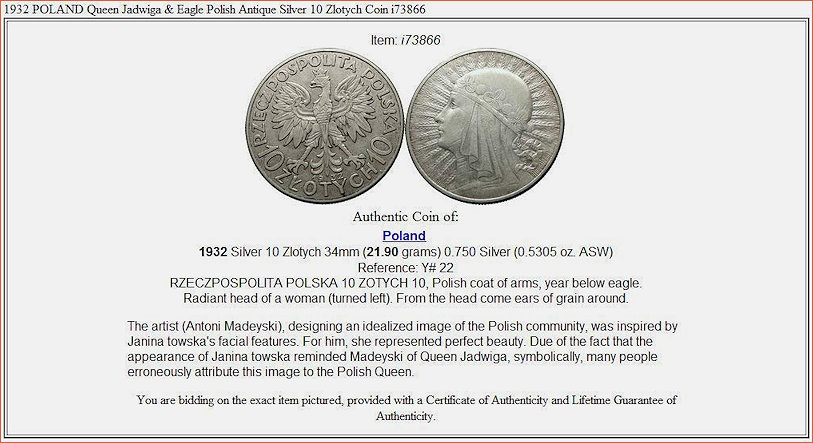
Image sourced from Amazon.com (they obviously had issues with the models name which is : Janina Żółtowska
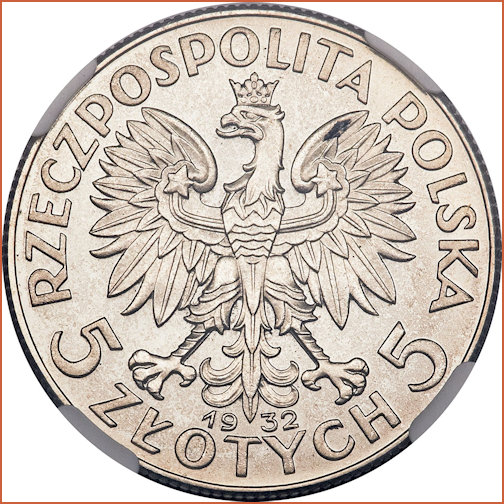
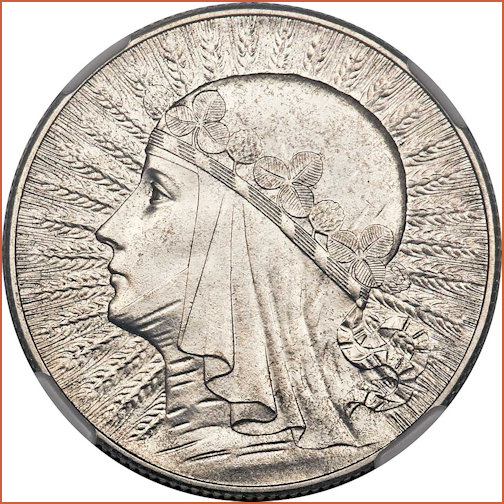
Images sourced from and courtesy of CoinBrothers
In the interwar period, there was a general opinion that the woman on the reverse was the Queen Jadwiga (the first female monarch of the Kingdom of Poland, reigning from 16 October 1384 until her death), since the artist Antoni Madeyski (16th October 1862 - 2nd February 1939) also made the sarcophagus of the Queen for the Wawel Cathedral.

I was astonished to see the detail of the pillow on which Jadwiga's head is lying - could it be a coincidence that Barbara Hulanicki's iconic logo bears such a strong resemblance?
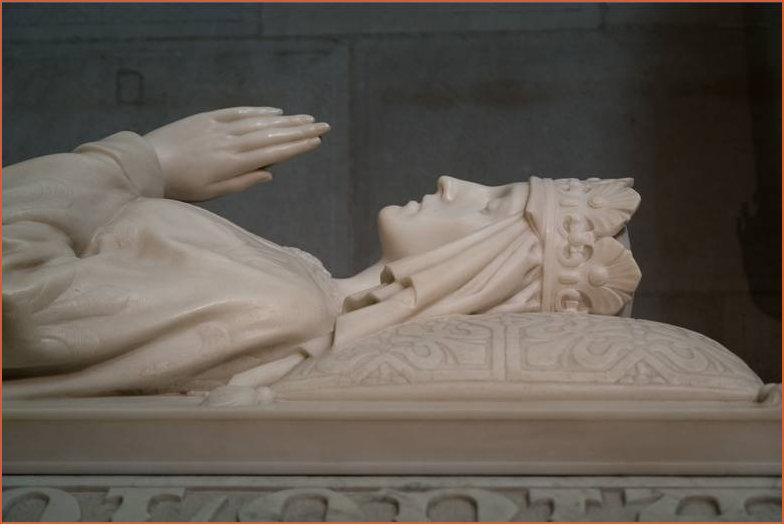
Sarcophagus sculpted by Antoni Madeyski - image courtesy & © of Anna Kaczmarz as seen in Gazeta Krakowska
According to the traditions of the artist's family, he immortalized in this image an idealized portrait of his niece Wanda Syrokomska-Petrażycka. According to others, the model was Janina Żółtowska (who visited Madeyski in the Roman workshop before the First World War), later the wife of Ludwik Hieronim Morstin. In 1923 he was a Polish military attaché in Rome, a friend of Antoni Madeyski.
Obverse
Animal (fish, bird, mammal etc.) Eagle
Coat of arms Poland
Crowned eagle with wings open, country name above, date and value below.
Royal Mint has no mintmark. Mintmark of Warsaw Mint (tiny arrow from the Kościesza coat of arms, a Polish coat of arms used by szlachta (nobility) families in the times of Kingdom of Poland) is in space between eagle's talons.
The coat of arms of Poland is a white, crowned eagle with a golden beak and talons, on a red background.
RZECZPOSPOLITA POLSKA - 1932 - 5 ZŁOTYCH 5
Reverse
People (man, woman, child etc.) Woman
Symbol Polonia
Radiant head of a woman (Polonia, a symbol of Poland, turned left). From the head come ears of grain around.
Edge - Reeded (milled) - Source : CoinBrothers
But my adventure with the coins was not over, I was able to buy a set of 2 x 10 złoty pieces for my sister and one each of the 5 zł and 10 zł for myself - result! as they say.

Image and narrative as seen on Etsy
Images sourced from Numista.com - 5 złoty and 10 złoty pieces
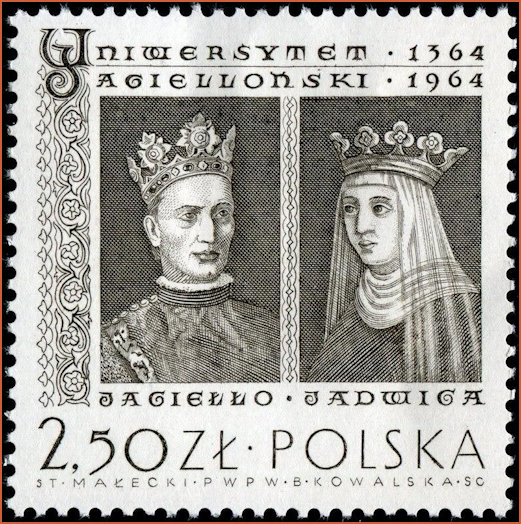
A stamp commemorating the 600th anniversary of the Jagiełło University was issued in 1964 - image sourced from colnect.com - not as idealised as the coinage issued over 30 years earlier.
Wawel

Sarcophagus sculpted by Antoni Madeyski - image courtesy & © of Anna Kaczmarz as seen in Gazeta Krakowska
Powrót Jadwigi do ludu
Dokładnie 616 lat temu, 17 lipca 1399 roku, zmarła na Wawelu królowa Jadwiga. Jej ostatnie zachowane słowa, jakie zawarła w liście do króla Władysława Jagiełły jeszcze przed porodem, świadczą, że przeczuwała śmierć. Kiedy mąż przypominał, by przyozdobiła swoją komnatę tkaninami ze złotem, perłami i klejnotami, Jadwiga odpisała: "Już od dawna wyrzekłam się pychy i próżności tego świata, a tem mniej mogłabym myśleć o niej w chwili śmierci, która często zdarza się w połogu…". 22 czerwca przyszła przedwcześnie na świat Elżbieta Bonifacja. Niezwykle wątłe dziecko niebawem zmarło. Królowa popadała coraz bardziej w niemoc. Gasnąca w oczach Jadwiga dożyła dnia 17 lipca, godziny trzynastej…
Lato 1949 roku
Przez wieki miejsce spoczynku królowej było niewidoczne i mało znane ogółowi. Od dawna planowano przeniesienie jej szczątków w eksponowane miejsce - wszak gotowy dla niej sarkofag, dłuta Antoniego Madeyskiego - czekał od roku 1902! Książę kard. Adam Stefan Sapieha postanowił naprawić błędy przeszłości, z największym uszanowaniem wydobyć prochy królowej Jadwigi, od XVII w. spoczywające w mało widocznym miejscu, i przenieść je do okazałego sarkofagu, w pobliże kaplicy Zygmuntowskiej.
11 lipca 1949 o godz. 9 stawili się na Wawelu członkowie komisji otwarcia grobu, m.in.: J.E. X Adam Sapieha, kanonicy kapituły katedralnej, profesorowie UJ, reprezentanci władz, literaci Artur Górski i Lech Beynar (czyli Paweł Jasienica). Robotnicy przystąpili o godz. 9.10 do odsłaniania płyty przez odbijanie cegły i zaprawy murarskiej. Odsłonięta płyta z jednolitego kamienia wapiennego wykazywała wiele uszkodzeń: wskazują na to, że próbowano już kilkakrotnie zaglądać do środka grobu. O godz. 10.30 przystąpiono do podważania płyty za pomocą automatycznej windy i podsuwanych belek w miarę podnoszenia jej w górę. Książę kardynał towarzyszył pracom, siedząc w fotelu przed grobem. O 11.25 odsłoniło się obecnym wnętrze grobu, w którym na 10 sztabach wpuszczonych w ściany tumby spoczywała prostokątna paka drewniana przykryta nie wiekiem, ale zwykłymi deskami. Paka znajdowała się w doskonałym stanie i u góry miała wyżłobienia do wsuwania wieka, które niewątpliwie musiało być sporządzone razem z nią. Dlaczego wieka brak było w grobowcu, dlaczego trumnę nakryto zwykłymi deskami, to pozostanie niewyjaśnioną zagadką. Widoczne było naruszanie ściany grobu w rogu od strony schodów, gdzie przez wyjęcie jednego kamienia utworzył się otwór w 1887 roku. Ta drogą weszli wówczas architekt Odrzywolski i Jan Matejko.
Ks. bp Rospond wezwał obecnych do uklęknięcia i odmówienia modlitwy. Następnie zeszli na dół laborant Franciszek Sikorski i jeden z robotników, i stanęli obok trumny, zdejmując deski wierzchnie. Ukazało się wtedy leżące pośrodku jabłko królewskie oraz wypukłość głowy, przykrytej - jak cała postać królowej Jadwigi - tkaniną brunatnej barwy. Pakę z całą zawartością i wśród wielkiego wzruszenia przeniesiono do skarbca katedralnego, gdzie o godz. 13 złożono drogie szczątki na jednym z trzech przygotowanych stołów. Tutaj odczytano dekret o ekskomunice w wypadku zabrania jakichkolwiek części osobistych królowej Jadwigi.
Nastrój niezwykłości
O godz. 14.30 prof. Olbrycht jako biegły sądowy przystąpił do badania zwłok. Przygotowane stoły nakryto białymi płótnami dla zebrania nawet pyłu ze szczątków. Opodal leżał pergaminowy dokument mający być włożony do nowej trumny miedzianej i drugiej nieco większej drewnianej, już przygotowanych do uroczystego przeniesienia zwłok do sarkofagu. Przed stołami ustawione w kilku rzędach fotele zajęli członkowie komisji z księciem kardynałem na czele. Pośród szaf z koronami królewskimi, płaszczy koronacyjnych, złotych kielichów i monstrancji, na tle zabytków skarbca - naukowe i kanoniczne badanie zwłok królowej Jadwigi odbywało się zgodnie z założeniami. Złote krzyże i łańcuchy oraz czerwień kardynalska i fiolety dostojników przenosiły zebranych do dawnej świetności z czasów królowej Jadwigi. Zamknięta katedra, tłumy ciekawych poza bramami, uwijający się robotnicy porządkujący grób z gruzu i wynoszący go na wewnętrzny dziedziniec przy kaplicy Zygmuntowskiej, to wszystko tworzyło nastrój niezwykłości. Po usunięciu resztek materii, którą była przykryta królowa Jadwiga, oczom obecnych ukazała się doskonale zachowana czaszka z oczodołami. Charakterystyczne było ułożenie postaci Jadwigi, zbliżone do jednego z boków trumny, co można było wytłumaczyć tym, że obok niegdyś leżała jej zmarła córeczka Elżbieta Bonifacja. Naturalnie nie znaleziono jej szczątków, gdyż po 550 latach z trzydniowego dziecka, mającego miękkie chrząstki, nic pozostać nie mogło. To ułożenie ciała świadczyło też, że ciało nie było ruszane od dnia pogrzebu! Po wyjęciu berła drewnianego o charakterystycznym gotyckim ornamencie, następnie jabłka królewskiego, zaczęto poszukiwać korony. Znaleziono w okolicy głowy resztki ornamentu gotyckiego wyciętego w skórze i także przypuszczalnie pozłacanego. Czy to resztki korony, trudno orzec. Pozłótka musiała być wykonana ze złota dukatowego, gdyż choć odpadła od pozłacanych insygniów, to jednak dookoła rozsiany był drobny pył złoty, który zachował swój piękny złoty blask.
Choć wszystko było skromne, jak skromna była królowa Jadwiga, jeszcze na łożu śmierci podkreślająca nieprzywiązywanie wagi do splendorów doczesnych, to jednak w niczym nie uchybiało majestatowi królewskiemu. Widać miano tu wzgląd na Jagiełłę, który stosując się do ostatniej woli Jadwigi, nie omieszkał jednak pochować żony jako królowej. Stąd insygnia zastąpiono drewnianą imitacją, a koronę, być może, wycięto ze skóry. Szkielet królowej wyłożono na osobnym stole. Kości miednicy wskazywały na budowę wąską i mało rozłożystą. Gdy prof. Olbrycht złożył kości miednicy widoczne było, że budowa królowej utrudniała poród i był to jeszcze jeden dowód przyczyny śmierci dziecka i Jadwigi. Duże, długie i doskonale zachowane, podobnie jak cały kościec, kości udowe wskazywały na wysoki wzrost. Profesor ustalił wzrost na ok. 180 cm, a następnie przepiłowawszy kość ramieniową, określił górną granicę wieku jako nie wyższą niż 28 lat. Te wszystkie szczegóły wspierają badania historyczne, według których królowa Jadwiga umierając nie miała ukończonych 26 lat.
Kardynał Sapieha naznaczył powtórny pogrzeb królowej Jadwigi na 14 lipca 1949 roku na godz. 17. O oznaczonej porze przybyli dostojnicy duchowni oraz profesorowie Uniwersytetu Jagiellońskiego, którzy przy dźwiękach dzwonu Zygmunta wzięli na ramiona trumnę Jadwigi. Idąc ze skarbca lewą nawą stanął orszak pogrzebowy przed sarkofagiem Madeyskiego, który czekał na szczątki królowej przez 47 długich lat.
Żywy kult i pamięć
Kardynał Sapieha, decydując się na umieszczenie szczątków królowej w sarkofagu obok kaplicy Zygmuntowskiej, chciał uprzystępnić je wiernym, gdyż kult Jadwigi był w Polsce żywy, a pamięć jej niezwykłego poświęcenia dla ojczyzny, ofiary dla ubogich, mądrości politycznej - trwała. Do tego czasu jej grobowiec, znajdując się pod posadzką prezbiterium katedry, był niedostępny, i tylko mała grupa osób wiedziała, w którym miejscu znajduje się grób. Kolejnych przenosin szczątków Jadwigi dokonał już Jan Paweł II. Trafiła, za jego przyczyną, na ołtarz.
Nagrobek św. Jadwigi
Pierwotnie królowa wraz z córką została pochowana w 1399 r. w prezbiterium na lewo od ołtarza głównego.
W 1949 r. przeniesiono ją do sarkofagu wykonanego z białego marmuru kararyjskiego przez Antoniego Madeyskiego już w 1902 r . Na wierzchniej płycie jest postać królowej ze złożonymi do modlitwy rękami oraz psem symbolizującym wierność pod stopami. Boki sarkofagu dekorowane są fryzem z orłami i herbami Andegawenów.
5 czerwca 1987 kard. Franciszek Macharski, przewodniczył kolejnej ekshumacji szczątków, które miały już potwierdzony przez Kościół status relikwii. Przełożono je do nowego relikwiarza z brązu, zaprojektowanego przez prof. Witolda Korskiego z Politechniki Krakowskiej. W czasie rozpoczętej kilka dni później wizyty Jana Pawła II w Krakowie, 10 czerwca został on umieszczony we wnęce ołtarza Pana Jezusa Ukrzyżowanego. Source : Gazeta Krakowska
Jadwiga Slaska (Silesia)
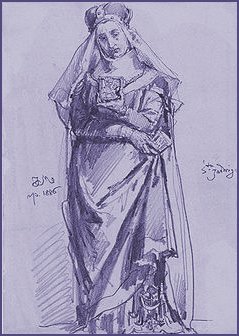
Hedy Lamarr
Actress known for the scandal that was perpetrated in 1933 when she starred in 'Ecstasy' which reached no. 8 in the top 50 Cinema listings in 1933 but also a woman inventor!
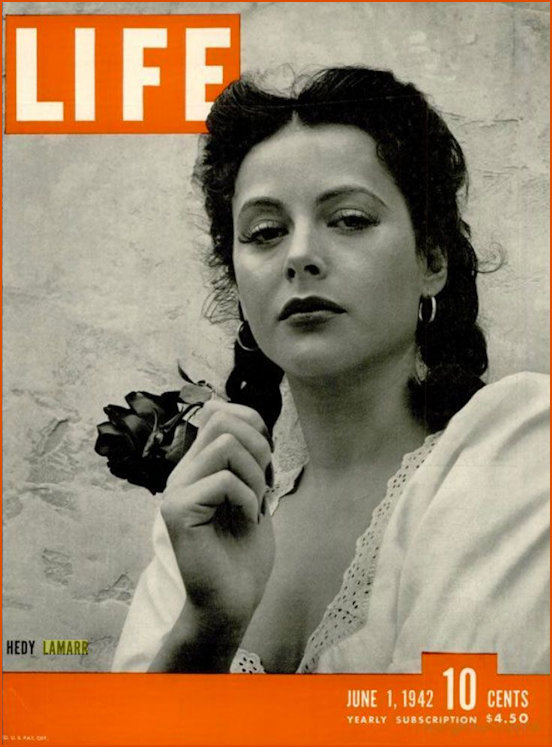
Hedy Lamarr the glamorous film actress on the cover of the 1st of June, 1942 Life Magazine cover - image sourced via The Guardian & time.com
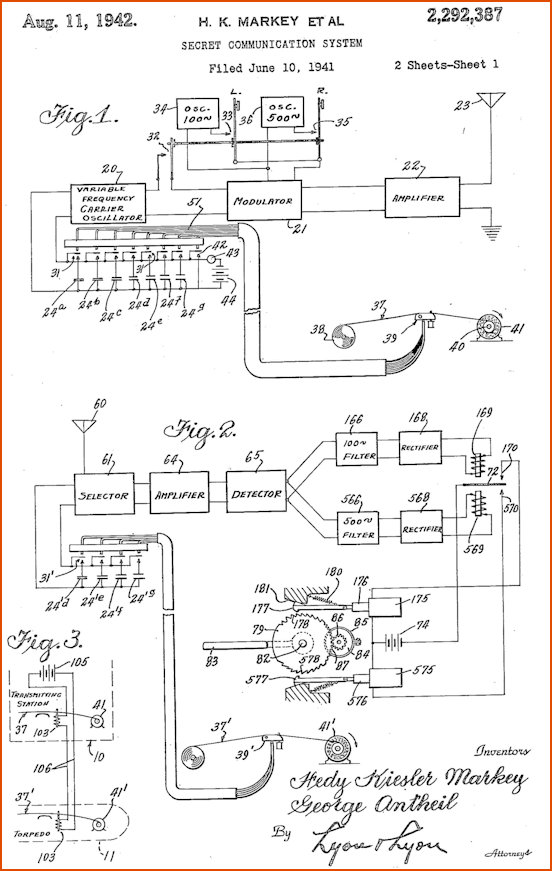
But what would her adoring public have thought of this Inventors patent lodged in August 1942 which would eventually lead to the development of the wi-fi that we are so reliant on today? - Image sourced from The Guardian - Lamarr's patent, filed in 1941, was developed with the American composer George Antheil. Photograph: USPTO
Although she achieved international fame as a Hollywood movie star, Lamarr was not satisfied by acting. In her trailer between takes, and staying up all night at home, she practised her favourite hobby: inventing. In an audio recording used in Bombshell, she discusses her love of science, her failed experiments (effervescent cola tablets) and her successes, including streamlining her lover Howard Hughes's racing aeroplane. "I don't have to work on ideas," she says. "They come naturally." Lamarr's greatest scientific triumph was intended for the US navy during the second world war, but is now used in modern wireless communication. Her "secret communication system" used "frequency hopping" to guide radio-controlled missiles underwater in a way that was undetectable by the enemy. It was Lamarr's brainwave (though some say she may have first seen a sketch of a similar idea in the office of her first husband, the Austrian munitions manufacturer Fritz Mandl) and she developed it together with a friend, the composer George Antheil. The patent was granted in 1942.
The military took her idea and eventually used it, but Lamarr was advised that she would make a greater contribution to the war effort as a pinup rather than as an inventor: entertaining troops, pushing war bonds and, as the documentary notes, selling kisses. Lamarr's invention didn't become widely known until near the end of her life, in the late 1990s. It gained more traction when her obituaries were published in 2000. Since then the news has spread and she has become an icon of women in science – in comic books, plays and even that modern monument, a Google Doodle. All the time that Lamarr was making big films in Hollywood (and missing out on even more, including Casablanca and Gaslight) the press kept writing about her love life (six marriages and six divorces), and her sultry, kittenish looks. Anything but her invention – despite the fact that it had actually been made public in 1941. The National Inventors Council leaked the story to the press, leading the LA Times to call Lamarr a "screen siren and inventor … [whose] invention, held secret by the government, is considered of great potential value in the national defense program". The story disappeared and by 1944, when Motion Picture Magazine referred to Lamarr's intelligence, it was talking about her "discovering a new headdress". As Lamarr aged, she became a joke – even the ghostwriter of her memoirs turned them into something so "fictional, false, vulgar, scandalous, libelous and obscene" that she sued the publishers. Source : The Guardian
Jadwiga Piłsudska-Jaraczewska
Daughter of Polish national hero Marshał Józef Piłsudski - obituary
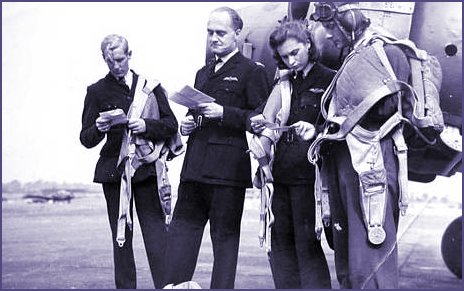
Jadwiga Piłsudska-Jaraczewska with officers during the war
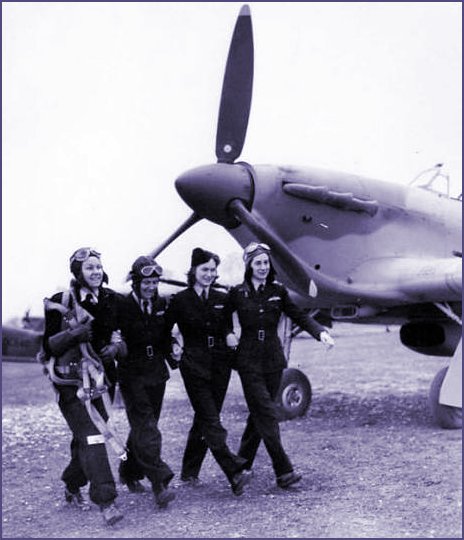
Jadwiga Piłsudska-Jaraczewska (second from right) with other ATA pilots during the war
Images courtesy of The Daily Telegraph
Jadwiga "Apostoł" (Apostle)
Member of the Polish Resistance / Concentration Camp survivor
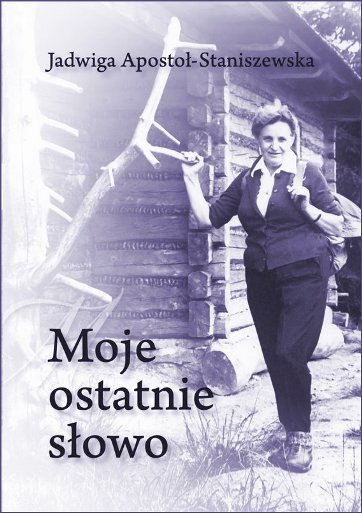
Hedwig - the Harry Potter Owl
Why did J.K.R choose this particular name for Harry's Owl I wonder? Was she just mesmerised by the beauty of the name or did she revere any of the great heroine's that had previously owned the name?
According to the literary 'lore' - "Harry Potter's Trusted Owl, was named Hedwig. He found this name in his 'History of Magic' textbook." But this still doesn't explain why J.K.R chose it!
A very determined contributor to behindthename.com states '"Hedwig" was the name of a medieval saint, and that is where J.K. Rowling got the name.' I like it best of all the comments (you can see them by following the link) but why would J.K.R. use the name of a saint to name an owl (as a Roman Catholic I find that difficult to swallow) unless, it follows that many comments state that Hedwig was more than a pet or companion for Harry, she was endowed with protective powers, akin perhaps to a guardian angel in which case that could fit the bill but it still does not answer the question directly. Angelfire.com provides a comprehensive list of the unusual names and place names found in the book, for Hedwig the following is given - "Hedwig: In a recent interview, Mrs. Rowling said that Hedwig is the name of a medieval saint. Someone e-mailed me this very helpful site that has very good info on St. Hedwig. (Thanx!) St. Hedwig had seven children and was married several times. She cared for the sick and supported the poor. There's a school named for her, this school provides education for abandoned and orphaned children. Do you see a connection here? Hedwig, the owl, cares for Harry who is orphaned, and this school named after St. Hedwig cares for the orphaned." This is unhelpful on two counts - 1) when was this interview (what does 'recent' mean and where was it published/transmitted?) and which website was provided for a much-married saint?
Wiki (after following several links) gives us : "Hedwig is Harry Potter's owl, given to him in Harry Potter and the Philosopher's Stone as an eleventh birthday present by Rubeus Hagrid, who purchases the owl in Diagon Alley at the Eeylops Owl Emporium. Harry gives her this name after reading it in a book on the history of magic. Hedwig is used for delivering messages throughout the series, and also serves as a companion to Harry, especially when he is unable to interact with other wizards. It is implied throughout the books that Hedwig can fully understand Harry's speech. In the fifth book, Order of the Phoenix, Hedwig is intercepted by Dolores Umbridge and is hurt, but is later healed by Professor Grubbly-Plank. In the seventh book, The Deathly Hallows, Hedwig is killed by a curse from a Death Eater; in the film version, she is killed defending Harry from the Death Eater. According to Rowling, Hedwig's death represents the loss of Harry's innocence. Although the character of Hedwig is female, she is played on film by male owls (female snowy owls have dark patches of plumage, while only the males are completely white). The John Williams composition which serves as title music for the entire film series is named "Hedwig's Theme". " I love the fact that Hedwig is up there with 'Dr. Zhivago and Lara's theme' by having one of her own (I didn't know that before!)
Big debate on Snitchsneeker.com about Hedwig's demise and a gobble-de-gook response from J.K.R. which doesn't help a bit - I think I'll leave it for the time being!
Even if I cannot find the answer to this, I can at least appreciate the '4 reasons' of explanation on the Pottermore website!
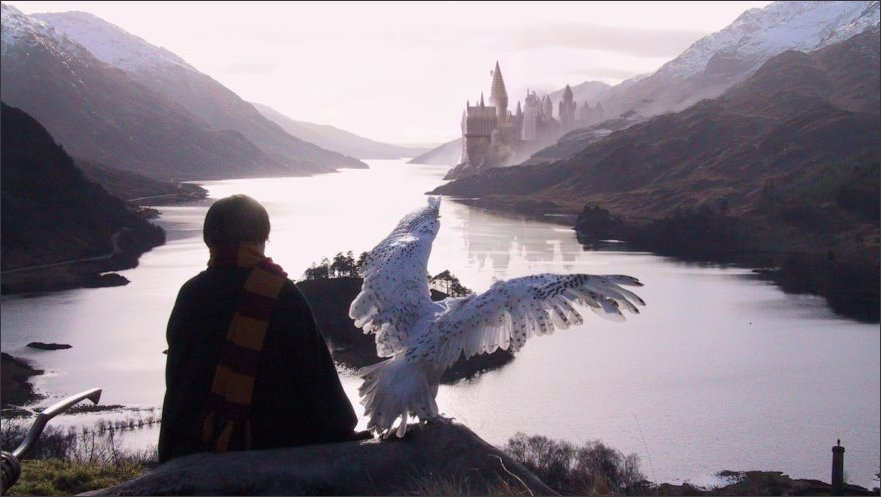
Image sourced from 'Harry Potter and the Chamber of Secrets' as featured on the Pottermore website
4 reasons Hedwig was better than everyone else at Hogwarts
Hedwig was one of J.K. Rowling's most beloved creations – perhaps even more so than some of her human characters.
It's unlikely that there's a single Harry Potter fan who didn't shed a tear when Hedwig was killed in Harry Potter and the Deathly Hallows. Despite a distinct lack of dialogue beyond the occasional hoot, Hedwig was a favourite of many fans of the series. Here's why…
Hedwig had character
She may not have been able to vocalise it, but you know that Hedwig had a feisty spirit. How many times did she gaze at Harry reproachfully or nip his finger, or cuff him about the head with an outstretched wing…
"The soup was stone cold, but he drank half of it in one gulp. Then he crossed the room to Hedwig's cage and tipped the soggy vegetables at the bottom of the bowl into her empty food tray. She ruffled her feathers and gave him a look of deep disgust. 'It's no good turning your beak up at it, that's all we've got,' said Harry grimly." - Harry Potter and the Chamber of Secrets
Hedwig was more than Harry's pet
While Harry stayed with the Dursleys every summer, Hedwig was one of the few reminders he had that Hogwarts was real. She was his constant connection to the wizarding world up until her death. She wasn't just a pet to Harry, or a creature to deliver his post; she was also a friend. As Harry says in Order of the Phoenix, Hedwig 'was the only friend he had at number four, Privet Drive'.
"When Harry felt overwhelmed (or couldn't deal with Ron and Hermione's bickering) he would often visit Hedwig's roost in the Hogwarts owlery. Her silent comfort and the quiet of the owlery was something of a refuge. She nipped his finger, perhaps rather harder than she would ordinarily have done, but hooted softly in a reassuring sort of way all the same." - Harry Potter and the Goblet of Fire
She was smart (and not just for a bird)
Hedwig (and the same could be said of the other owls at Hogwarts – except maybe Pigwidgeon) proved time and time again that she had more smarts than your average snowy owl.
"She always knew that a letter addressed to Snuffles was intended for Sirius; and now that we think of it, never even needed an address to be written on an envelope. She was also able to follow more complex instructions, such as 'keep pecking [Ron and Hermione] till they've written decent-length answers' in Order of the Phoenix. She always managed to show up wherever Harry was, even when he had run away from Privet Drive. Harry was something of a homing beacon for Hedwig – and that's perhaps because they were each other's home. She sometimes flew in to nibble his ear and have a bit of toast before going off to sleep in the owlery with the other school owls." - Harry Potter and the Philosopher's Stone
She really meant something to readers
Nothing proved how important Hedwig was more than the reaction of fans when she was killed during the Battle of the Seven Potters in Deathly Hallows. In the book, Hedwig was killed as she sat in her cage by Harry's side – as she had so many times before – as they attempted to escape on the back of Hagrid's motorcycle. In the film, the scene was made even more heartbreaking, as Hedwig was killed while attempting to protect Harry from Death Eaters.
J.K. Rowling has said previously: 'The loss of Hedwig represented a loss of innocence and security. She has been almost like a cuddly toy to Harry at times. Voldemort killing her marked the end of childhood. I'm sorry... I know that death upset a LOT of people!'
"'No – HEDWIG!'
The broomstick spun to earth, but he just managed to seize the strap of his rucksack and the top of the cage as the motorbike swung the right way up again. A second's relief, and then another burst of green light. The owl screeched and fell to the floor of the cage.
'No – NO!'
The motorbike zoomed forward; Harry glimpsed hooded Death Eaters scattering as Hagrid blasted through their circle.
'Hedwig – Hedwig --'
But the owl lay motionless and pathetic as a toy on the floor of her cage." - Harry Potter and the Deathly Hallows

Well I did my polite best and this is the response - thank you very much J K Rowling for your thoughtful, transparent, well-balanced, well-thought out, timebound, non-discriminatory response - you've had a taste of the medicine the trolls have lavished on you for your opinions, I sympathised with you over that, well not any longer. The question of why Hedwig received such a noxious variation of a beautiful name is closed!
Page refreshed : 10th September 2020 (G)

